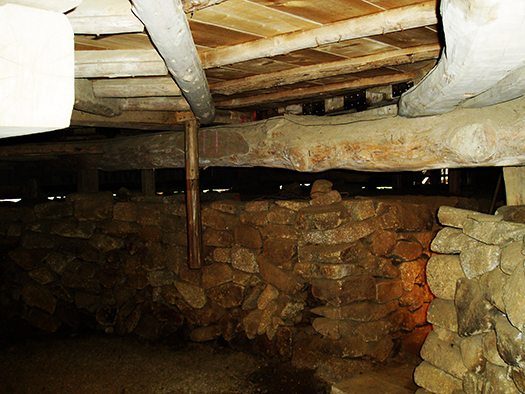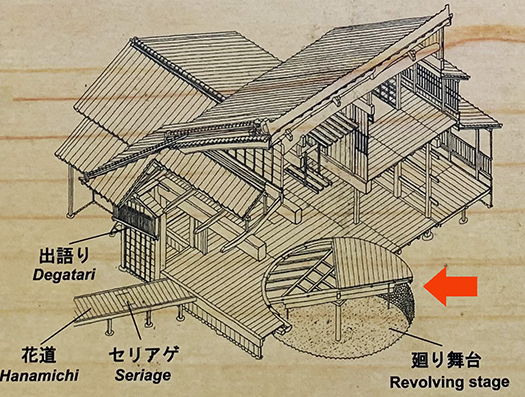

写真は「三重・船越の舞台」の縁の下空間、回り舞台の回転部地下。
画面の真ん中に太い「操作棒」が下がっています。
舞台の上の役者さんの動きに合わせて床を回転させる仕掛け。
円形にかたどられた石の基礎に木での回転仕掛けが造作されている。
石を固めた基礎部分と円形をつなぎ合わせた土台で回転部分の床を支えている。
操作棒を全身で動かすことで回転動作させていたようです。
舞台上での役者の動きに建築仕掛け的な大道具演出を加えて
見せ場をより視覚的なオモシロさで訴求させたもの。本格的。
舞台建築というものは、通常の建築とは違ってこういった
「仕掛け」部分が重要な要素になるものだと思われるので、
かなり専門的な技術を持った職人・大工さんたちが関わっていたのでしょう。
江戸期には「からくり人形」のような工作技術が発展したので
そうした知識の最先端の江戸や上方の町人文化地域で
先端技術者と大工職人がコラボして考えていったものでしょうね。
たぶん建築が作られる度にあらたな工夫がそこに盛り込まれていって、
舞台芸術との協業が大いに追求されていって
ある定型化というようなことも深化していったように思われます。
この船越の舞台でも、この回転舞台装置の他、舞台の上方にはブドウ棚、
ワタリなどの舞台機構も。舞台正面の右手と左手に1坪の「出語り」が
張り出している。これは上下2段になっていて右手は下部が囃場で上部が太夫座、
左手は下部が小道具入れで上部が花座(勧進元の座)というように
芝居装置としての多機能性がさまざまに装置されている。
江戸期には全国各地でこうした「舞台」が造営されたとされる。
演劇が大衆化していって芸能が庶民から希求されたのでしょう。
舞台建築の専門大工集団というような職能集団が存在したのでしょう。
江戸期の市民文化は浮世絵などに象徴されるように大変な盛り上がりで
芸能への関心も全国津々浦々で盛り上がっていった。
その媒体としてこうした建築が求められて建てられていったのでしょう。
きのう地域の神社の祭礼に合わせて芝居が掛かったと書きましたが、
全国各地域で芝居舞台が建築されていったとすると、
その需要だけでも相当の建築棟数になることが容易に想像できる。
中国地方ではいまも神楽が大人気ですが、
わたしも一時期はけっこう楽しませていただいた。そういった空気感が
この江戸期の舞台からもたっぷりと漂ってくる。
神楽、能、狂言、歌舞伎とジャンルは変遷するけれど、
日本人には舞台への陶酔共感の思いがひときわ強いのではと思います。
English version⬇
[Karakuri “building technology of Noh stage / Japanese good house ㉛-2]
The photo shows the space below the edge of the “Mie / Funakoshi Stage”, the basement of the rotating part of the rotating stage.
There is a thick “operation stick” in the middle of the screen.
A mechanism to rotate the floor according to the movement of the actor on the stage.
A rotating device made of wood is built on a stone foundation that is shaped like a circle.
It seems that it was rotated by moving the operation rod with the whole body.
Adding architectural props to the movements of the actors on the stage
It will appeal to the showcase with a more visual humor.
The floor of the rotating part is supported by a foundation that connects the foundation part made of stone and the circle.
Stage architecture is different from ordinary architecture in this way
Since the “device” part seems to be an important factor,
It seems that some kind of craftsmen with quite specialized skills were involved.
In the Edo period, crafting techniques such as “karakuri dolls” developed.
The cutting edge of such knowledge is in Edo and the upper tradesman cultural area.
It must have been a collaboration between a high-tech engineer and a carpenter.
Perhaps every time an architecture is made, new ideas are incorporated into it.
Collaboration with performing arts is being pursued greatly
It seems that a certain stylization has deepened.
Even on this Funakoshi stage, in addition to this revolving stage set, there is a grape shelf above the stage.
There is also a stage mechanism such as Watari. On the right and left sides of the front of the stage, there is a 1 tsubo “speaking story”
Overhanging. This is a two-tiered top and bottom, with the lower part on the right and the upper part on the Tayuza.
On the left hand, the lower part is the prop case and the upper part is the flower seat (the seat of the promotion source).
Various functions of the play are installed.
It is said that such “stages” were built all over the country during the Edo period.
It seems that theater has become popular and that kind of performing art has been sought after.
Was there a professional group such as a group of carpenters specializing in stage architecture?
Citizen’s culture in the Edo period was very exciting as symbolized by ukiyo-e prints.
Interest in performing arts also grew all over the country.
It seems that such architecture was sought and built as the medium.
I wrote that the play was performed at the festival of the shrine in the area yesterday.
If a play stage was built in each region of the country,
It is easy to imagine that the demand alone will result in a considerable number of buildings.
Kagura is still very popular in the Chugoku region,
I also enjoyed it for a while. That kind of atmosphere
It drifts a lot from the stage of the Edo period.
Kagura, Noh, Kabuki, Kyogen and genres change, but
I think that Japanese people have a strong feeling of euphoria for the stage.
Posted on 5月 19th, 2021 by 三木 奎吾
Filed under: 住宅マーケティング, 日本社会・文化研究







コメントを投稿
「※誹謗中傷や、悪意のある書き込み、営利目的などのコメントを防ぐために、投稿された全てのコメントは一時的に保留されますのでご了承ください。」
You must be logged in to post a comment.